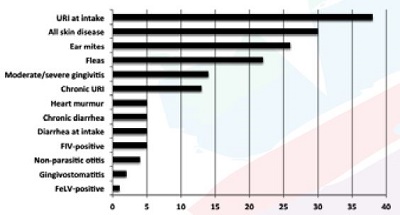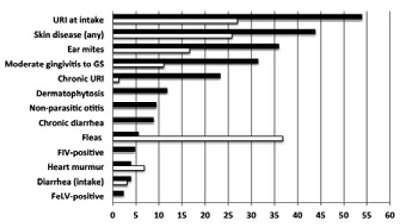Animal Hoarding Animal Welfare Experiences from Different Countries and Cultures: Part 1b
L. Jacobson
Medical conditions in hoarded animals are the predictable result of overcrowding, poor sanitation and failure to provide appropriate medical and emotional care.1-5 Upper respiratory infection (URI) is an almost-universal problem in hoarded cats. Other conditions are found less consistently but may be present in most or all animals in a given setting. They include matted coats, emaciation, wounds and other physical injuries, dermatophytosis, fleas, ear mites, demodicosis, scabies, oral and dental disease, ticks and tickborne diseases, intestinal parasites, diarrhea and retroviral infections. Polydactyly or heart murmurs can reflect inbreeding.
A study of 371 cats from 14 different groups, surrendered to the Toronto Humane Society (THS) over a 3-year period, showed a spectrum of prevalence of medical conditions, with URI (38%) and dermatological disease (30%) being the most common overall (Figure 1; manuscript submitted for publication). The odds of URI at intake (4.35) and chronic URI (23.7) were significantly higher for cats from institutional hoarding environments compared with home environments (Figure 2).
Figure 1

Disease prevalence (%) in 371 hoarded cats from 14 sources, surrendered to the Toronto Humane Society over a 3-year period
Figure 2

Comparison of disease prevalence (%) between 128 cats from institutional hoarding environments (IH; black bars) and 163 cats from non-institutional hoarders (NIH; white bars). GS = gingivostomatitis. Comparisons could not be made for conditions not present in the NIH cats. After accounting for clustering within groups, significant differences were found between IH and NIH for URI at intake and chronic upper respiratory infection (URI)
Veterinarians should suspect hoarding if animals are presented with medical conditions consistent with those outlined above, particularly if these occur in multiple animals from the same home or rescue/shelter. Practitioners who are knowledgeable about shelter medicine are a valuable resource for community veterinarians dealing with animal hoarding.
Unpublished data on behaviour in hoarded cats described a group of cats housed in a compound in the Nevada desert.5 Most of these cats were very friendly, probably in response to having been deprived of normal human contact. Compared with control cats, they were friendlier toward unfamiliar people and cats. There were no significant differences between hoarded and control cats for litterbox use, aggression, night-time vocalization or a variety of fearful behaviours.
Hoarded cats at the Toronto Humane Society show a range of socialization levels, behaviours and temperaments (manuscript in preparation), as would be expected depending on intrinsic factors, the previous life experiences of the cats and the type of hoarding environment. Cats from one large-scale institutional hoarder were dubbed “Velcro cats” because of their obvious need for human contact. Inappropriate elimination has not been frequently identified compared with the general population, and was only rarely a concern in the new home in hoarded 100 cats followed post-adoption.
Long-term confinement in a hoarding setting can result in the establishment and persistence of unusually severe disease and/or unusual opportunistic infections.2,4,7 These include chronic infectious or parasitic diarrhea and unusual causes of respiratory disease. Streptococcus equi subspecies zooepidemicus (“Strep zoo” or SEZ) and other streptococcal infections have been reported in cats in institutional hoarding settings. Beta-hemolytic streptococcal infection caused multiple pyogenic syndromes in hoarded cats, including abscesses, purulent rhinitis, septic arthritis and meningitis. SEZ was found in 4/4 large-scale hoarding investigations.
The Toronto Humane Society has identified chronic rhinosinusitis and otitis media caused by SEZ in cats from two different institutional hoarders. This condition is typically found in long-stay cats. Cats that were removed after a short stay did not shown signs of SEZ infection, suggesting that it might become established secondary to chronic URI. Despite reports of acute SEZ epidemics in shelter dogs, SEZ appears to be a rare cause of acute disease in cats and in our experience does not appear to be contagious in a well-run shelter setting. Otitis media should be suspected in cats with persistent nasal congestion and in those with purulent otitis externa or friable dark aural discharge, particularly in the absence of ear mites. Most cases seen at the THS gave been severe and have required ventral bulla osteotomy for effective treatment. SEZ has been regularly cultured from the tympanic bulla at surgery despite previous courses of appropriate antibiotics.
Emotional suffering in shelter settings is profound, given the combination of crowding, illness, abnormal interactions between animals and limited opportunity for normal interactions with people.5,6 Long-term emotional consequences will vary depending on the level of early socialization, behavioural issues prior to entering the hoarding environment, severity and duration of stress and psychological trauma, and the animal’s internal resilience.
Many previously hoarded dogs suffer from high levels of fear.6 When compared with normal dogs, they showed higher average scores for stranger-directed, dog-directed and non-social fear, increased sensitivity to touch, more attention-seeking and separation-related behaviours, a higher rate of inappropriate urination and defecation and more repetitive behaviours. They also showed less aggression towards strangers, lower trainability and less excitability, energy and persistent barking. Persistent fear may be due to poor socialization, limited exposure to novel stimuli during the sensitive development period, and psychological trauma.
Fear of other dogs might result from negative experiences in the hoarding setting. Lower scores for aggression and energy may be due to inhibition of competitive behaviour and learned helplessness in the face of ongoing stress.
Most previously hoarded cats that enter the THS shelter are ultimately adoptable, with high adopter satisfaction scores from 100 adopters who were contacted at least a month after adoption. However, significant medical, behavioural and foster resources are typically required to restore an acceptable level of medical and behavioural health to animals that have suffered in hoarding environments.
References
1. Patronek GJ. Hoarding of animals: an under-recognized public health problem in a difficult-to-study population. Public Health Rep. 1999;114:81–87.
2. Polak KC, Levy JK, Crawford PC, et al. Infectious diseases in large-scale cat hoarding investigations. Vet J. 2014;201:189–195.
3. Andersen LA, Levy JK, McManus CM, et al. Prevalence of enteropathogens in cats with and without diarrhea in four different management models for unowned cats in the southeast United States. Vet J. 2018;236:49–55.
5. Morrow BL, McNatt R, Joyce L, et al. Highly pathogenic beta-hemolytic streptococcal infections in cats from an institutionalized hoarding facility and a multi-species comparison. J Feline Med Surg. 2015;18:318–327.
6. McMillan F. Physical and psychological health issues in puppy mill and hoarding rescues. University of Florida’s Maddie’s Shelter Medicine Conference; 2012. (last accessed Sep 3, 2018), www.maddiesfund.org/physical-and-psych-issues-in-mills-and-hoarding.htm.
8. McMillan FD, Vanderstichel R, Stryhn H, et al. Behavioural characteristics of dogs removed from hoarding situations. Appl Anim Behav Sci. 2016;178:69–79.
9. Brooks JW, Roberts EL, Kocher K, et al. Fatal pneumonia caused by extraintestinal pathogenic Escherichia coli (ExPEC) in a juvenile cat recovered from an animal hoarding incident. Vet Microbiol. 2013;167:704–707.